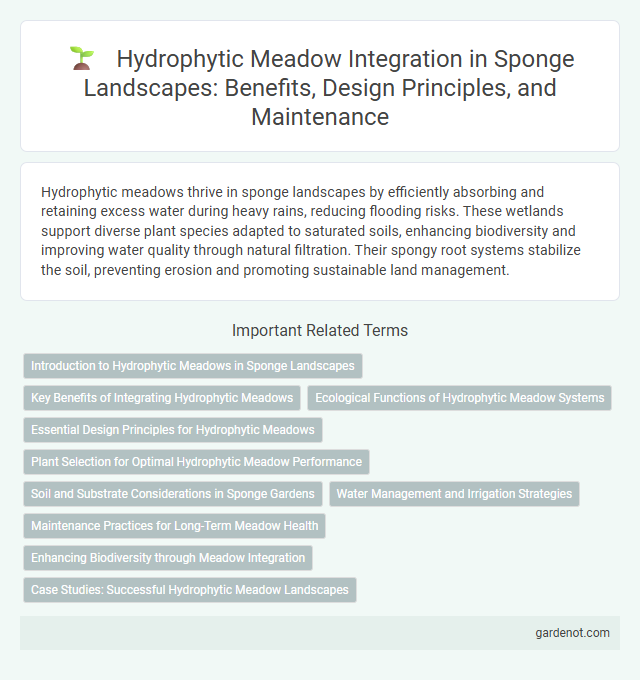Hydrophytic meadows thrive in sponge landscapes by efficiently absorbing and retaining excess water during heavy rains, reducing flooding risks. These wetlands support diverse plant species adapted to saturated soils, enhancing biodiversity and improving water quality through natural filtration. Their spongy root systems stabilize the soil, preventing erosion and promoting sustainable land management.
Introduction to Hydrophytic Meadows in Sponge Landscapes
Hydrophytic meadows within sponge landscapes play a critical role in water absorption and retention due to their dense, water-loving vegetation adapted to saturated soil conditions. These meadows enhance groundwater recharge, reduce surface runoff, and support biodiversity by providing habitat for aquatic and semi-aquatic species. Integrating hydrophytic meadows into sponge landscapes improves natural flood control and water quality through the filtration of pollutants.
Key Benefits of Integrating Hydrophytic Meadows
Hydrophytic meadows enhance urban sponge landscapes by improving water infiltration and reducing surface runoff, which helps mitigate flooding. These meadows provide critical habitat for wetland species and support biodiversity through their native, water-tolerant vegetation. Their root structures stabilize soil and filter pollutants, contributing to improved water quality and ecosystem health.
Ecological Functions of Hydrophytic Meadow Systems
Hydrophytic meadows play a crucial role in water filtration by trapping sediments and absorbing pollutants, thereby improving water quality in sponge landscapes. These meadow systems support biodiversity by providing habitat for a variety of aquatic and terrestrial species, enhancing ecosystem resilience. Their dense vegetation also aids in flood mitigation by slowing water flow and promoting groundwater recharge.
Essential Design Principles for Hydrophytic Meadows
Hydrophytic meadows thrive on carefully balanced water saturation, requiring soil with high organic content and consistent moisture levels to support diverse wetland plant species. Incorporating native hydrophytic vegetation such as sedges, rushes, and wetland grasses enhances ecological function and promotes biodiversity. Strategic grading and hydrology management ensure optimal water retention and seasonal flooding, crucial for maintaining the meadow's sponge landscape effectiveness.
Plant Selection for Optimal Hydrophytic Meadow Performance
Selecting native hydrophytic plants such as Carex, Juncus, and Scirpus species enhances hydrophytic meadow performance by promoting water filtration, soil stabilization, and habitat diversity. Prioritizing species with high tolerance to saturated soils and fluctuating water levels ensures long-term ecosystem resilience and efficient stormwater management. Integrating a mix of emergent, submergent, and floating vegetation optimizes nutrient uptake and supports a balanced aquatic food web.
Soil and Substrate Considerations in Sponge Gardens
Hydrophytic meadows in sponge gardens thrive on soils rich in organic matter with excellent moisture retention and aeration properties, critical for supporting wetland vegetation. Substrates should be composed of loamy or silty textures to facilitate water filtration and root penetration while preventing compaction. Proper soil pH ranging from 5.5 to 7.0 enhances nutrient availability, promoting healthy growth of hydrophytic plant species essential for effective water absorption and retention in sponge landscapes.
Water Management and Irrigation Strategies
Hydrophytic meadows excel in water management by naturally filtering and retaining stormwater, reducing runoff and promoting groundwater recharge. Their dense vegetation supports efficient irrigation strategies by minimizing evaporation and maximizing soil moisture retention. Integrating these meadows into sponge landscapes enhances sustainable urban water cycles and reduces the need for external irrigation inputs.
Maintenance Practices for Long-Term Meadow Health
Regular mowing at optimal heights prevents woody plant encroachment and promotes diverse hydrophytic meadow species. Seasonal removal of excess biomass reduces nutrient buildup, ensuring balanced soil conditions critical for long-term meadow vitality. Strategic invasive species management preserves native plant dominance and supports effective water filtration in sponge landscape systems.
Enhancing Biodiversity through Meadow Integration
Integrating hydrophytic meadows into sponge landscapes significantly enhances biodiversity by providing critical habitats for wetland flora and fauna, including various amphibians, pollinators, and bird species. These meadows improve water quality through natural filtration processes and support a wide array of native plant species adapted to saturated soils. The increased habitat complexity and nutrient cycling within hydrophytic meadows foster resilient ecosystems that mitigate flood risks and promote ecological balance.
Case Studies: Successful Hydrophytic Meadow Landscapes
Hydrophytic meadow landscapes demonstrate effective water retention and biodiversity enhancement in urban sponge city designs. Case studies in regions like the Netherlands and Singapore reveal that integrating native hydrophytic plants improves flood mitigation while supporting local wildlife habitats. These projects highlight the synergy between ecological function and aesthetic value, promoting sustainable urban water management.
Hydrophytic meadow Infographic

 gardenot.com
gardenot.com